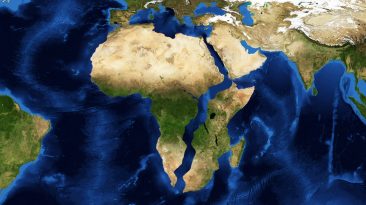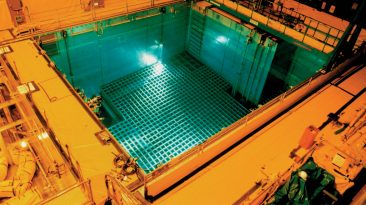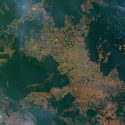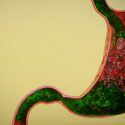What would life on Mars look like? Would we be able to live on the surface, or have to hide underground from all the solar radiation Mars gets exposed to? Would we be able to terraform it?
The Mars You Know:
Ever felt like getting off this planet? Well, consider Mars… 4th Rock from the Sun. It can be as close as 56 million km (34.8 million miles) to us. It can also be as far as 401 million km (250 million miles) away. Mars is about fifty three percent of the size of Earth, making it the second smallest planet in our solar system (after Mercury).
Mars is named for the Roman god of war. The city of Cairo, in Egypt, is actually named after Mars, allegedly because the planet was rising on the day that Cairo was founded. The first spacecraft to Mars was in 1965, and was called the Mariner 4.
Mars has two moons, Phobos and Deimos. It’s also home to the largest recorded mountain in the solar system, and the largest recorded dust storms.
Mars and the Earth have about the same amount of land mass. Mars gets its distinctive red color from iron-rich minerals covering its surface. The temperature on Mars can fall to a low of -153 degrees Celsius (–225 degrees Fahrenheit) and rise to a high of 20 degrees Celsius (70 degrees Fahrenheit).
Various discoveries throughout the years suggest that Mars may have had life at some point. In 2014, NASA’s Curiosity Rover discovered pockets of methane, which they believe suggested that Mars may have had some sort of life at some point.
Scientists have also found evidence of water and other necessities for human life present on the planet. However, these ancient oceans would provide around one percent of the water present in Earth’s oceans. There are other features of Earth which also used to be present on Mars. There is evidence that Mars used to have polar ice caps.
So, what would happen if we fled to the red planet?
What If We All Moved To Mars?
Even if you jumped into the fastest spacecraft ever launched from Earth, getting there would take anywhere from 40 days to 9.5 months, depending on the position of the planets. And after all that time in space, you’d finally see dry and lifeless Mars on the horizon. But would you be able to survive there? What would you need to survive on Mars anyway?
First off, you’d have to figure out how to produce oxygen to breathe. The Martian atmosphere is very thin and it’s 95% carbon dioxide. You wouldn’t be able to just bring all the oxygen you’d need to survive, but you could extract it from the CO2 with machines like NASA’s “MOXIE.”
Not only would that provide you and other Martian settlers with breathable air, but also supply you with liquid oxygen propellant. That’s the stuff you’d need to lift a rocket off Mars – in case you decided to return to Earth. There’s no soil on Mars to grow food in. Instead, you’d use hydroponics – cultivating your crops in a mineral and nutrient solution, no soil required.
Of course, without running water on the surface, your colony would only be able to grow about 20% of the food you’d need. The rest of it you’d have shipped in from Earth. But don’t expect fresh meat – all your food would come dried.
Where Would We Live?
Along with the other settlers, you’d probably live in inflatable pressurized buildings. But it’s more likely that you’d go underground. Because Mars has no global geomagnetic field, and since its atmosphere is so thin, radiation levels in the orbit above Mars are 2.5 times higher than at the International Space Station. That is too much solar radiation for humans to bear.
Forget about suntanning. The Sun would appear just half as big as it does from Earth. And if you want to go outside and return alive, you’d need a spacesuit to make up for the near-absent atmospheric pressure and to block radiation.
Your suit would also keep you warm, which is important because temperatures on Mars are very low. The coldest winter on Earth is paradise compared to the average Martian winter. Temperatures would be as low as -55 °C (-67 °F). Even colder at the poles, where the temperatures can drop to a freezing -153 °C (243 °F).
A day on Mars is just 40 minutes longer than a day on Earth. A year on Mars would be almost twice as long, though. If you lived in the northern hemisphere, you’d enjoy seven months of spring and six months of summer. Then there would be a five-months long autumn and another four months of winter.
And not only are the temperatures there low, they also can change dramatically within a week. These variations often result in powerful dust storms. They wouldn’t harm you, but would clog all your electronics. Facetiming with somebody from home would be next to impossible, because whatever you say would take about 15 minutes to get to Earth.
Remember too, that the gravity on Mars is about one third of the Earth’s. You’d need to learn how to walk again. Still want to move to the red planet? Well, your . best bet is to wait until the first human colonies head there to terraform the planet – to make it just like the one they came from.
Ice, Ice, Baby:
They’d import ammonia ice from the atmospheres of other planets to heat Mars up a little. The heat would convert the dry ice at the Martian north pole into gas and give the planet an atmosphere. Still unbreathable for us, but at least it would be enough to create atmospheric pressure so that you could finally take off your spacesuit.
Then they’d extract water from the vast reserves of water-ice locked away beneath the Mars’ surface. Water vapor would make the atmosphere thicker and thicker. Eventually, you’d see it raining and snowing on Mars. And after maybe a thousand years, there’d be enough oxygen for humans to breathe. The planet re-engineering would be complete.
Is living on Mars is something you’d like to try? Or would you rather preserve what we have here on Earth?
Sources
- Your kids might live on Mars. Here’s how they’ll survive.
- HOW DO WE COLONIZE MARS?
- Populating a Mars Base Will Be Dangerously Unsexy
- How Long Does It Take to Get to Mars?
- MARS FACTS
- Mars Facts: Life, Water and Robots on the Red Planet
- Fun Facts About Mars
- 10 amazing facts you probably didn’t know about the Red Planet
- 12 Awesome Facts About Mars That Will Make You Love The Red Planet Even More
- Mars Facts
- Featured Image Source:D Mitriy on Wiki Commons



























